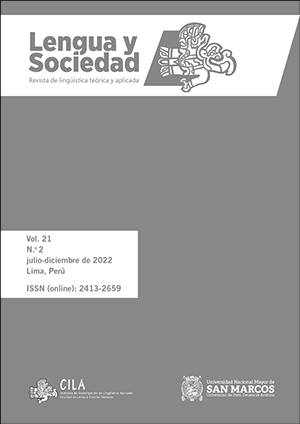Communication: spaces and collective memories. Case study
DOI:
https://doi.org/10.15381/lengsoc.v21i2.22554Keywords:
MMCDS, space-time, collective memory, CMPR, semiotic landscapeAbstract
In the current socio-political situation in Colombia and in the post-agreement scenario (2016), in coexistence with the internal armed conflict, the relationship between memory and space is reflected; it is formulated from its communicative and political character, taking into account, as a starting point, that memory is a social construction, anchored in space-time in the daily life of communities, formulated as a subjective interaction, which, when socialized, becomes collectivized; that is, it has an intersubjective nature, managing dialogic and social networks, updating ways of knowing reality and influencing the transformations of communities.
The objective is to formulate a reflection on the socio-discursive and political-cultural construction of memory, to address space-time in a place of memory in Bogotá; relationship that is characterized by having a communicative, symbolic and political dimension. In a first point, the relationship between memory and socio-communicative practices with the processes of construction of meaning is addressed. Second, the memory-space-place relationship in the national territory is explored, and how it serves as an anchor for the memory of the Colombian armed conflict, whose temporality exceeds six decades. In this process of design, production and socialization, the symbolic-discursive dimension is installed. Finally, in the third point, the Peace and Reconciliation Memory Center of the Capital District-Bogotá is analyzed semiotic-discursively, as part of the symbolic-public landscape, whose material and actional concretion is the sense of multiculturalism, social and political heterogeneity.
References
Acuerdo Final para la Terminación del Conflicto y la Construcción de una Paz Estable y Duradera, 12 de noviembre de 2016. https://www.jep.gov.co/Normativa/Paginas/Acuerdo-Final.aspx
Badawi, H. (26 de junio de 2018). La obra de Beatriz González en el Cementerio Central estaría en riesgo. Revista Arcadia. https://www.revistaarcadia.com/periodismo-cultural---revista-arcadia/articulo/obra-sobre-el-bogotazo-de-beatriz-gonzalez-en-peligro-en-administracion-de-penalosa/69793
Berger, P. y Luckmann, T. (2001). La construcción social de la realidad. Amorrortu Editores.
Cap, P. (2010). Axiological aspects of proximization. Journal of Pragmatics, 42(2), 392-407. https://doi.org/10.1016/j.pragma.2009.06.008
Cárdenas, F. (2016). El signo paisaje cultural desde los horizontes de la antropología semiótica. AIBR: Revista de Antropología Iberoamericana, 11(1), 105-129. https://www.redalyc.org/pdf/623/62345164006.pdf
Chilton, P. (2004). Analysing political discourse: Theory and practice. Routledge.
CMPR. (2022). Información general. http://centromemoria.gov.co/informacion-general/
CMPR. (2008). Centro de Memoria Paz y Reconciliación. http://centromemoria.gov.co/que-es/
Dávila, R. (2015). CMPR [Fotografía]. AXXIS. https://www.revistaaxxis.com.co/arquitectura/centro-de-memoria-paz-y-reconciliacion/
Escobar, E. (2014). Semiótica y comunicación. Teoría de los signos y los códigos. Lengua y Sociedad, 14(1), 175-204. https://doi.org/10.15381/lengsoc.v14i1.22613
Estrada, J. (2019). El Acuerdo de paz en Colombia. Entre la perfidia y la potencia transformadora. CLACSO.
Goffman, E. (2006). The presentation of the self. En D. Brissett y C. Edgley (Eds.), Life As Theater: A Dramaturgical Sourcebook (pp. 129-139). Aldine Transaction.
Gorlée, D. (2020). Paraphrase or parasite? Chinese Semiotic Studies, 16(1), 1-46. https://doi.org/10.1515/css-2020-0001
Hodges, A. (2011). The “War on Terror” Narrative: Discourse and Intertextuality in the Construction and Contestation of Sociopolitical Reality. Oxford University Press.
Huffschmid, A. (2013). La otra materialidad: cuerpos y memoria en la vía pública. En M. Aguilar y P. Soto (Coords.), Cuerpos, espacios y emociones. Aproximaciones desde las ciencias sociales (pp. 111-138). Porrúa-Universidad Autónoma Metropolitana.
Jelin, E. (2020). La historicidad de las memorias. Mélanges de la Casa de Velázquez. Nouvelle série, 50(1), 285-290. https://doi.org/10.4000/mcv.12902
Lindström, K., Palang, H. y Kull, K. (2018). Landscape semiotics. En P. Howard et. al (Eds.), The Routledge Companion to Landscape Studies (pp. 74-90). Routledge.
Lleras, C. (10 de febrero de 2020). Sería fácil llamarlo censura. Detrás de los cambios del guion del Museo de Memoria de Colombia. Revista Semana. https://www.semana.com/arte/articulo/seria-facil-llamarlo-censura-detras-de-los-cambios-del-guion-del-museo-de-memoria-de-colombia/80568/
Ortiz, J. P. Arquitectos. (2013). Centro de Memoria, Paz y Reconciliación. ArchDaily. https://www.archdaily.co/co/760956/centro-de-memoria-paz-y-reconciliacion-juan-pablo-ortiz-arquitectos
Peirce, Ch. (1986). La ciencia de la semiótica. Nueva Visión.
Ramírez, B. y López, L. (2015). Espacio, paisaje, región, territorio y lugar: la diversidad en el pensamiento contemporáneo. Universidad Nacional Autónoma de México.
Ricoeur, P. (2010). La memoria, la historia, el olvido. FCE.
Sánchez, G. (2019). Memorias, subjetividades y política. Planeta.
SIVIC. (2020). Víctimas residentes en Bogotá. Observatorio Distrital de Víctimas. https://observatorio.victimasbogota.gov.co/sites/default/files/documentos/2020.07%20BoletinVBC%20%281Julio%29.pdf
Tenbrink, T. (2011). Reference frames of space and time in language. Journal of Pragmatics, 43(3), 704-722. https://doi.org/10.1016/j.pragma.2010.06.020
Unidad de Víctimas. (2022). Reportes. https://www.unidadvictimas.gov.co/es/registro-unico-de-victimas-ruv/37394
van Dijk, T. (2016). Discurso y conocimiento. Gedisa.
Downloads
Published
Issue
Section
License
Copyright (c) 2022 Neyla Graciela Pardo Abril

This work is licensed under a Creative Commons Attribution 4.0 International License.
AUTHORS RETAIN THEIR RIGHTS
a. Authors retain their trade mark rights and patent, and also on any process or procedure described in the article.
b. Authors can submit to the journal Lengua y Sociedad, papers disseminated as pre-print in repositories. This should be made known in the cover letter.
c. Authors retain their right to share, copy, distribute, perform and publicly communicate their article (eg, to place their article in an institutional repository or publish it in a book), with an acknowledgment of its initial publication in the journal Lengua y Sociedad.
d. Authors retain theirs right to make a subsequent publication of their work, to use the article or any part thereof (eg a compilation of his papers, lecture notes, thesis, or a book), always indicating its initial publication in the journal Lengua y Sociedad (the originator of the work, journal, volume, number and date).






